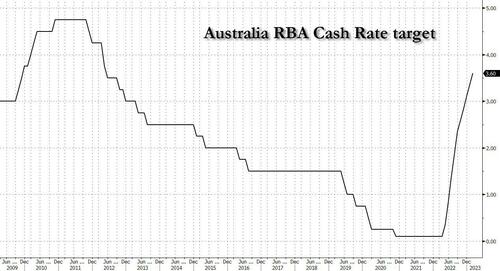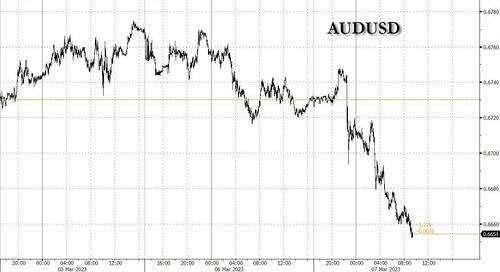Aussie Slides After RBA Hikes Rates For 10th Consecutive Time, Says Inflation Has Likely Peaked
Overnight, the RBA increased the cash rate for the 10th consecutive time by +25bp to 3.60% at March’s Board meeting – the highest level since May 2012 and in line with expectations.
While the statement maintained a clear hawkish bias, noting that the Board “expects that further tightening of monetary policy will be needed”, the tightening bias was notably softer than February’s alongside the RBA’s observation that “labour market conditions have eased a little”, the risk of a price-wage spiral has lessened, and inflation has likely peaked.
According to Goldman analysts, today’s statement provides the RBA some optionality to pause the tightening cycle in the event that the recent weakness in the monthly labor force reports is sustained. That said, Goldman expects a solid rebound in next week’s employment data as unusually large seasonal distortions unwind. Ultimately, with the unemployment rate near a 50-year low, inflation far above target, substantial excess savings supporting household balance sheets, and the Fed Funds rate likely to rise to 5.25-5.50% – the bank believes that a materially higher RBA cash rate will likely be required to bring inflation back to target on a credible timeframe.
Governor Philip Lowe said in his statement that in assessing “when and how much further” rates need to go up, the RBA will pay close attention to incoming economic data.
Looking forward, Goldman expects the RBA to raise the cash rate +25bp in April and May to a terminal rate of 4.1% – with the risks skewed to a more elongated tightening cycle to a higher terminal rate.
Main Points from the RBA statement:
- The RBA increased the cash rate +25bp to 3.6% at March’s Board meeting, in line with expectations (31/31 forecasters surveyed by Bloomberg expected +25bp, including GS). The attending statement reiterated the Board’s priority “is to return inflation to target… if high inflation were to become entrenched in people’s expectations, it would be very costly to reduce later”, but also maintained it wanted to keep the economy “on an even keel”.
- The forward guidance in the final paragraph noted the Board “expects that further tightening of monetary policy will be needed”, a marginally more ambiguous statement compared to the previous guidance (“expects that further increases in interest rates will be needed over the months ahead”). The Board also added the words “when and” to the final sentence “in assessing when and how much further interest rates need to increase, the Board will be paying close attention to developments in the global economy, trends in household spending and the outlook for inflation and the labour market.” We viewed this as increasing the Board’s optionality around the timing of future hikes, including the option of a pause, in addition the magnitude of future hikes.
- On the domestic economy, the RBA’s comments were incrementally more dovish than the prior month on several fronts. The statement noted that growth in the Australian economy “has slowed”, as did household consumption growth “due to tighter financial conditions”, while the outlook for housing construction “has softened”.
- On the labour market, the RBA characterized conditions as “very tight” overall but noted they “have eased a little”, although it caveated that the weakness in January’s employment data “partly reflects changing seasonal patterns in labour hiring”.
- On wage growth, the RBA noted “at the aggregate level, wages growth is still consistent with the inflation target and recent data suggest a lower risk of a cycle in which prices and wages chase one another”, although it noted “the Board… remains alert to the risk of a prices-wages spiral”.
- On inflation, the RBA noted “the monthly CPI indicator suggests that inflation has peaked in Australia. Goods price inflation is expected to moderate over the months ahead due to both global developments and softer demand in Australia. Services price inflation remains high, with strong demand for some services over the summer”. Going forward the RBA continues to expect inflation to “decline this year and next” to be “around 3 per cent in mid-2025”.
The market clearly took the RBA statement as far more dovish than Goldman, and the AUD sold off after what was seen as a dovish hike, the currency sliding more than 1.1% on Tuesday.
Tyler Durden
Tue, 03/07/2023 – 09:35
Zero Hedge’s mission is to widen the scope of financial, economic and political information available to the professional investing public, to skeptically examine and, where necessary, attack the flaccid institution that financial journalism has become, to liberate oppressed knowledge, to provide analysis uninhibited by political constraint and to facilitate information’s unending quest for freedom. Visit https://www.zerohedge.com

